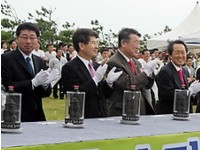South Korea Takes First Steps Toward the Smart Grid
 em>South Korea has launched a smart meter and grid pilot project with the goal to become the world’s first country with a nationwide smart grid system
em>South Korea has launched a smart meter and grid pilot project with the goal to become the world’s first country with a nationwide smart grid system This June, prior to this pilot project, South Korea made public its plans to build the world’s first nationwide smart grid system to reduce its emissions by monitoring energy use more carefully. Unlike conventional electricity grids, smart grids allow two-way communication between electricity suppliers and consumers, and enable more dispersed generation and storage of power. The government expects the grid to be set up by 2030, as a part of a $103 bn initiative to increase the generation of green energy from the current 2.4 per cent of total power to 11 per cent over the next two decades. According to KEMCO, the smart grid will enable utilities to get a more accurate view of energy use which could reduce carbon emissions by as much as 41 million tons and save $10 billion in energy imports. Korea Electric Power Corp. (KEPCO) also supports building a smart grid system using a Power Consumption Consulting System (PCCS), which is an energy portal service aimed at offering customers real-time information on their energy use and inducing them to save energy and money from Oct 12. Another project the State-run electricity monopoly plans to complete is a $65m smart grid pilot project on the country’s southern Je-ju Island by 2011. It would act as a test bed for the nationwide initiative. The grid will incorporate two 10MW substation transformers and four power distribution lines near an area with 3,000 households, commercial districts and green energy facilities that include a wind farm. In an interview with GLOBE-Net on Nov 3, Jae-Geun Lee, director of efficiency standard office of KEMCO, said that the institute expects to save 10% of energy consumption with the smart meter system alone, not to mention the energy savings from smart grid system. Setting the Standard Through this pilot project, KEMCO is establishing technological standards and selecting appropriate products and suppliers. From 2011, all programs and pilot projects are to be combined as “smart grid project” managed by the government affiliate KSGI (Korea Smart Grid Institute). “In this smart meter pilot project,” adds Lee, “Any wattmeter and electric products which meets the technology standard could participate regardless of the makers.” Mr. Lee presented GLOBE-Net with details of the smart meter specifications. Smart Specs As a smart meter system should comprise a Server, an interval meter, an energy information display and a communication protocol, here are the minimum standards for each of these components. Meters IHD (In-Home Display) All data should be displayed in graphic form Server Communication components More information: Korea Energy Management Corporation
You can return to the main Market News page, or press the Back button on your browser.

